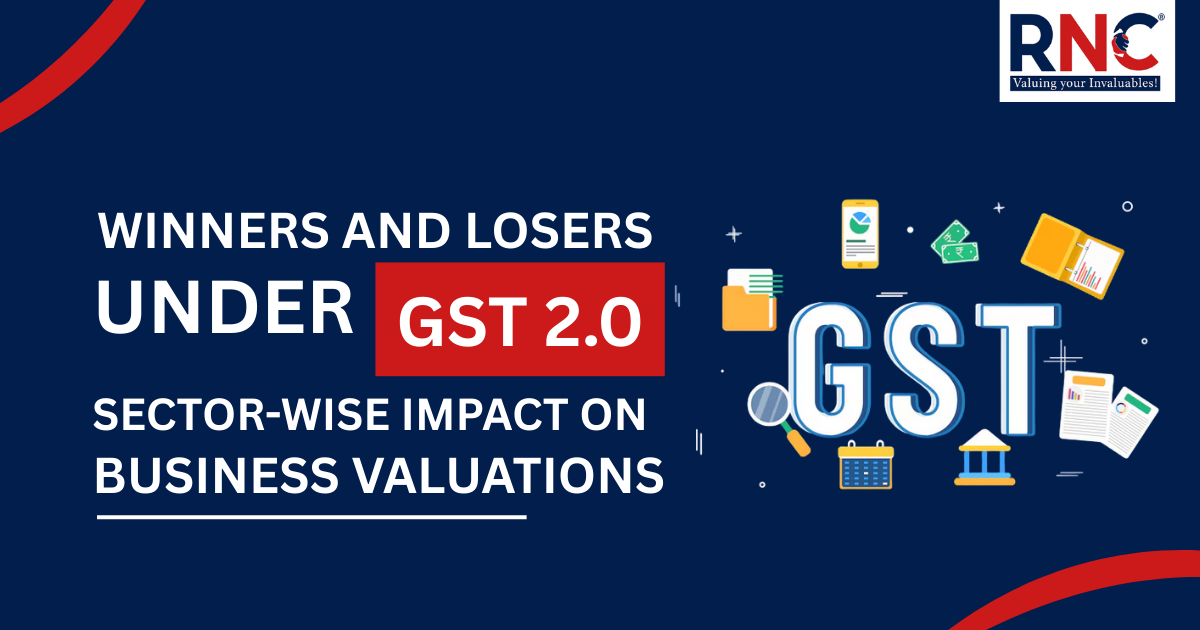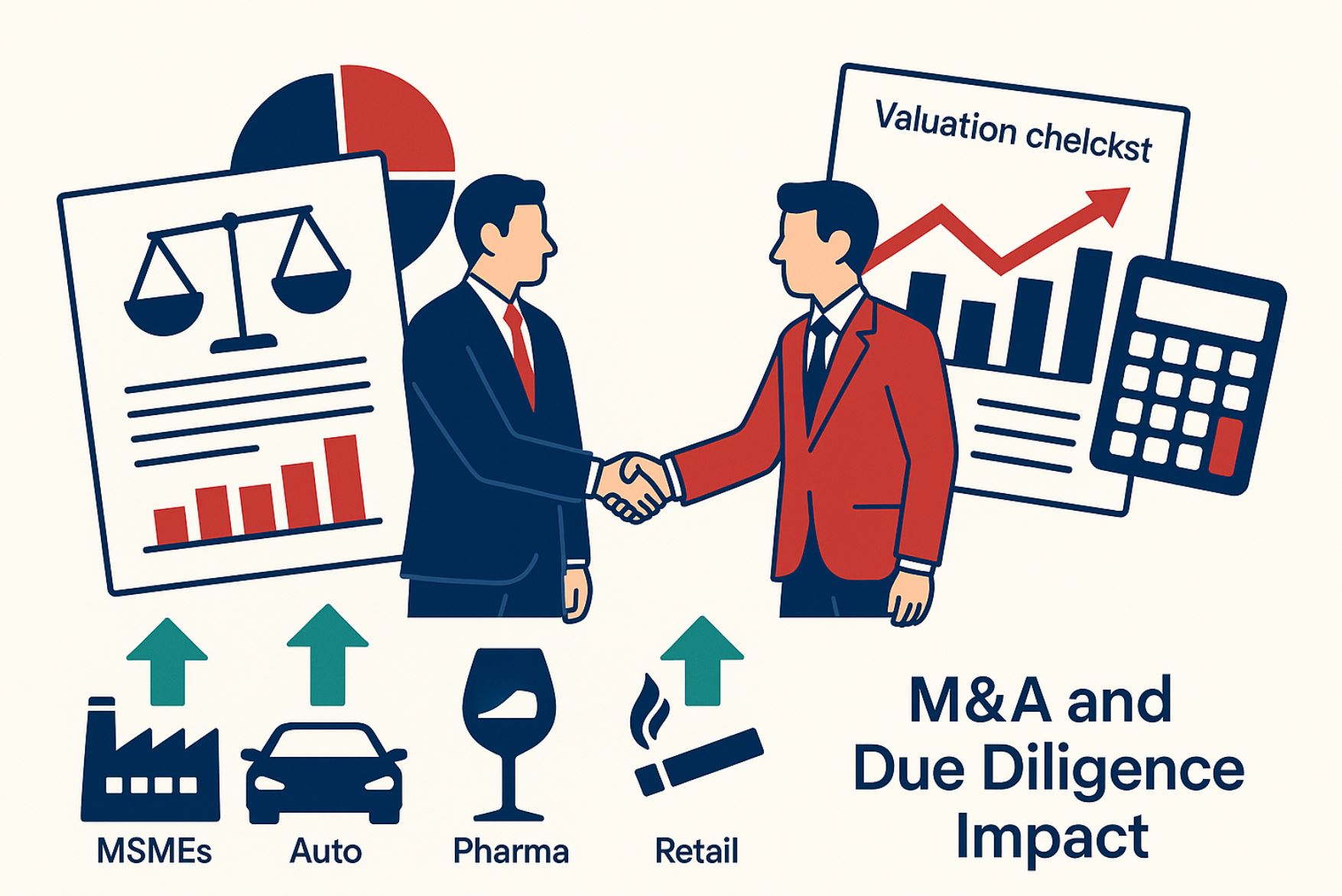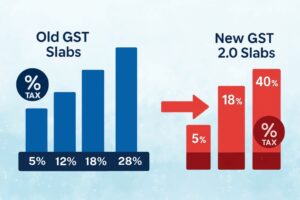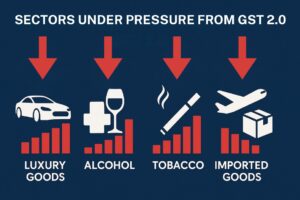
Why GST 2.0 Matters for Business Valuations
GST 2.0, effective September 22, 2025, marks one of the biggest overhauls in India’s indirect tax system. With simplified slabs of 5%, 18%, and 40%, it is set to redefine how businesses operate, forecast, and plan.
So far, media coverage has focused on what gets cheaper and what becomes costlier. Cars are expected to become more affordable, while luxury goods and tobacco products face steeper taxes. But there’s a deeper story here.
For business leaders, CFOs, and investors, the real question is: how does GST 2.0 impact business valuation? This goes beyond compliance—it directly influences company worth.
Every valuation depends on cash flows, margins, and risk premiums. GST 2.0 alters all three by changing pricing power, demand elasticity, and working capital efficiency. It is not just a tax reform—it is a valuation reset.
For businesses in sectors like MSMEs, auto, pharma, and retail, the reform could unlock new growth opportunities and improve earnings multiples. At the same time, industries like luxury, tobacco, and imported brands may see downward pressure on valuations.
Understanding these shifts is critical. Whether a company is raising funds, planning M&A, or preparing for an audit, the valuation models need to reflect GST 2.0 realities. Ignoring them risks mispricing, overpaying, or undervaluing.
“While headlines focus on cheaper cars and costlier luxuries, the real story of GST 2.0 is how it will reset business valuations across industries.”
In this blog, we break down GST 2.0 explained for businesses, highlight how GST 2.0 impacts business valuation, and map sector-wise winners and losers. We also include a real-world case study from the auto sector.
The goal is to move the conversation beyond “cheaper cars and costlier luxury goods” to what truly matters: how this reform reshapes company worth and investor decision-making.
GST 2.0 in Simple Terms
For businesses and investors, it’s important to start with the basics: what is GST 2.0 in India? In simple terms, it is the revamped Goods and Services Tax regime designed to simplify rates and spur consumption-led growth.
The new system comes into effect on September 22, 2025, and replaces the earlier structure of 5%, 12%, 18%, and 28% slabs with just three categories—5%, 18%, and 40%. This is a major reset that impacts pricing across industries.
The 5% slab now covers essentials such as medicines, stationery, agricultural inputs, and basic consumer goods. This means day-to-day items will be more affordable, driving higher demand volumes.
The 18% slab is the new standard rate, covering most goods and services including automobiles, consumer durables, and digital services. For many businesses, this shift creates room for stronger sales and healthier EBITDA margins.
A new 40% slab has been introduced for luxury and sin goods—tobacco, alcohol, imported liquor, high-end vehicles, and premium items. This is designed to discourage harmful consumption while also ensuring higher tax revenues.
Beyond rates, GST 2.0 simplifies compliance. Automated registration, faster refund processing, and a more streamlined billing system will improve working capital cycles—an important factor in DCF (Discounted Cash Flow) valuations.
In short, GST 2.0 explained for businesses is more than a change in taxation. It is a structural shift that alters demand elasticity, cash flow forecasting, and sectoral competitiveness—all of which directly influence how a company is valued.
Winners: Sectors Benefiting from GST 2.0
GST 2.0 is designed to stimulate consumption and ease compliance, and several industries stand to benefit directly. Lower tax rates on essentials, automobiles, and medicines will unlock demand, strengthen cash flows, and improve profitability. For sectors like MSMEs, auto, pharma, and retail, these shifts translate into higher revenue projections and stronger business valuations.
MSMEs and FMCG
Micro, small, and medium enterprises (MSMEs) stand to gain significantly under GST 2.0. With essentials like food items, stationery, and medicines now taxed at just 5%, demand is expected to surge.
For FMCG companies, this means stronger sales volumes and higher turnover. For valuation professionals, this translates into improved cash flow projections and a potential upward re-rating of valuation multiples.
Automobile Sector
One of the biggest winners is the automobile industry. Cars and two-wheelers that previously attracted 28% GST now fall under the 18% standard slab. This 10% reduction can cut consumer prices by almost a lakh rupees on mid-segment vehicles.
This structural change is likely to revive demand in a sector that has struggled with high costs and sluggish sales. For investors and analysts, auto companies may see stronger EBITDA margins and higher enterprise value (EV) to EBITDA multiples.
Read more: Impairment & EBITDA Impact in 2025 With Real Examples
Pharma & Healthcare
Medicines and life-saving drugs now fall under the 5% slab, making them more affordable for consumers. This is expected to increase demand, especially in semi-urban and rural markets.
For pharma and healthcare companies, higher sales volumes combined with stable margins improve DCF-based valuations. The sector could also see stronger investor interest due to its dual advantage of demand resilience and tax relief.
Learn more: Valuation of Under-Construction Projects Using Discounted Cash Flow (DCF) – Real Case Study
Retail & Consumer Goods
Retail and consumer-facing companies will benefit from cheaper essentials and durables, which encourage consumption-led growth. Organized retail chains and e-commerce platforms are well-positioned to capture this demand surge.
Higher revenues, better inventory turnover, and improved working capital cycles will positively impact business valuations in this sector. Investors are likely to re-rate retail companies upward as a result.
Takeaway for Businesses
The sectors gaining from GST 2.0 are not just looking at higher sales—they’re looking at valuation re-ratings. Improved demand, stronger EBITDA margins, and healthier cash flows all translate into higher company worth. At RNC, we specialize in capturing these shifts in our valuation models, ensuring businesses and investors can accurately measure the upside created by tax reforms like GST 2.0.
Losers: Sectors Under Pressure
While GST 2.0 boosts consumption in many areas, not every industry comes out ahead. Some sectors face higher taxes, demand compression, and valuation headwinds. For luxury goods, tobacco, and imported brands, the new 40% slab poses significant challenges.
Luxury Goods
High-end cars, premium electronics, and luxury accessories now fall under the 40% GST bracket. This steep hike makes such products less affordable, leading to weaker sales volumes. For valuation professionals, this means lower revenue forecasts and compressed earnings multiples.
Tobacco & Sin Products
Tobacco, cigarettes, and aerated drinks have been hit with the highest tax slab. Beyond reducing consumption, these products already face regulatory pressures. The combined effect is a negative outlook on cash flows and long-term valuations.
Imported Brands & Hospitality
Imported liquor, premium cosmetics, and other global lifestyle products face significant price hikes under GST 2.0. Hospitality businesses dependent on premium F&B sales may also experience reduced margins. For investors, this raises questions about sustainability of growth in these segments.
Takeaway for Businesses
For sectors under pressure, GST 2.0 is a valuation reset in the opposite direction. Higher tax incidence reduces demand elasticity, compresses cash flows, and erodes profitability. At RNC, our role is to help companies and investors reassess fair value under these new realities, ensuring decisions around M&A, fundraising, or portfolio allocation are grounded in accurate valuation insights.
Case Study: Auto Sector Valuation Shift
The automobile industry is one of the clearest winners under GST 2.0. Cars and two-wheelers, previously taxed at 28%, now fall into the 18% standard slab. This single change has a direct impact on pricing, demand, and ultimately, business valuation.
Before GST 2.0
- Base price of car: ₹10,00,000
- GST at 28%: ₹2,80,000
- Final price to consumer: ₹12,80,000
After GST 2.0
- Base price of car: ₹10,00,000
- GST at 18%: ₹1,80,000
- Final price to consumer: ₹11,80,000
Impact on Demand & Valuation
A ₹1,00,000 price reduction on a mid-range vehicle is expected to revive consumer demand significantly. Auto companies benefit from:
- Higher sales volumes → stronger revenue projections
- Improved production efficiency → better EBITDA margins
- Reduced inventory pressures → healthier cash flows
For investors and analysts, these factors translate into an upward revision of valuation multiples, particularly EV/EBITDA and Price-to-Earnings ratios.
Takeaway for Businesses
The auto sector shows how tax reform directly shapes valuation outcomes. A change in GST rates not only reduces consumer prices but also reshapes demand elasticity, profitability, and investor sentiment.
Valuation Impact Matrix: Before vs After GST 2.0
Policy changes like GST 2.0 don’t just alter tax incidence—they reshape entire valuation landscapes. To make this shift clearer, here’s a sector-wise Valuation Impact Matrix, comparing the old GST regime with the new one.
📊 Valuation Impact Matrix
| Sector | Old GST Rate | New GST 2.0 Rate | Valuation Impact | Key Takeaway |
| MSMEs / FMCG | 12% / 18% | 5% / 18% | Positive – demand surge, stronger revenues | Valuations re-rated upward due to higher volumes |
| Automobile | 28% | 18% | Positive – lower prices, higher demand | Higher sales & EBITDA margins → better multiples |
| Pharma & Healthcare | 12% | 5% | Positive – affordability, volume growth | DCF valuations strengthened by stable demand |
| Retail | 12% / 18% | 5% / 18% | Positive – consumption boost | Improved working capital cycles |
| Luxury Goods | 28% | 40% | Negative – demand compression | Lower sales & weaker PE multiples |
| Tobacco / Sin Goods | 28% | 40% | Negative – regulatory & demand decline | Cash flows under pressure, valuation outlook weak |
| Imported Brands | 28% | 40% | Negative – price hikes hurt demand | Hospitality & premium products face margin erosion |
This matrix highlights how GST 2.0 redistributes value across industries. Sectors like auto, MSMEs, pharma, and retail enjoy tailwinds for growth, while luxury, tobacco, and imports face valuation headwinds. For decision-makers, these shifts reinforce the need for updated, sector-sensitive valuations.
Implications for M&A and Due Diligence

GST 2.0 will not only reshape day-to-day operations but also change the way deals are evaluated in mergers and acquisitions. For buyers, sellers, and investors, the tax reform adds a new layer to valuation models and deal negotiations.
Adjusting Deal Models
Buyers will now model acquisitions with revised revenue forecasts, EBITDA margins, and cash flow assumptions under GST 2.0. For example, an auto manufacturer may command a premium due to stronger demand, while a luxury retailer may see valuation markdowns.
Red Flags in Due Diligence
In due diligence, tax incidence is now a key checkpoint. Businesses in luxury, tobacco, and imports may look profitable on old models but face valuation compression under the new GST slabs. Investors need to validate whether revenue projections account for post-GST realities.
Investor Portfolio Re-Rating
Institutional investors and private equity funds will re-rate their portfolios by sector. Consumption-driven businesses may see higher multiples, while sin and luxury-heavy portfolios could undergo corrections. This reshuffling reflects risk-adjusted valuations in a post-GST environment.
Takeaway for Businesses
GST 2.0 highlights the need for dynamic valuation frameworks in M&A and investment decisions. Static models that ignore tax reforms risk mispricing assets or overpaying in deals. At RNC, we help clients integrate policy shifts like GST 2.0 into their due diligence, acquisition pricing, and portfolio valuation strategies, ensuring informed and accurate decision-making.
Conclusion: Why Businesses Need Valuation Updates Post GST 2.0
GST 2.0 is more than just a tax reform—it is a valuation reset across industries. By restructuring slabs into 5%, 18%, and 40%, it has created clear winners in sectors like MSMEs, auto, pharma, and retail, while putting pressure on luxury, tobacco, and imported brands.
For businesses, this means the assumptions that once guided revenue forecasts, margins, and cash flows may no longer hold true. For investors, it demands a fresh look at sector multiples and portfolio allocations. And for companies exploring M&A or fundraising, it requires updated valuation models that capture these shifts.
The challenge lies in going beyond compliance to truly understand how GST 2.0 influences company worth. Valuations that fail to factor in these changes risk mispricing assets, misjudging risks, or missing growth opportunities.
At RNC, our role is to help businesses, investors, and decision-makers translate policy reforms into valuation realities. Whether it’s revising cash flow models, re-rating sectors, or conducting due diligence, we ensure valuations reflect the true market impact of GST 2.0.
The key takeaway: GST 2.0 doesn’t just change tax rates—it changes the way businesses are valued. Staying ahead of these shifts is essential for strategic decisions, and that’s where RNC brings its expertise.
FAQs
1. What is GST 2.0 and when does it come into effect?
GST 2.0 is the revamped Goods and Services Tax regime in India with slabs of 5%, 18%, and 40%. It comes into effect on September 22, 2025.
2. How does GST 2.0 impact business valuations?
GST 2.0 influences revenue forecasts, EBITDA margins, and cash flows. Sectors like auto, MSMEs, and pharma gain, while luxury and tobacco face valuation pressure.
3. Which sectors benefit from GST 2.0?
MSMEs, automobiles, pharma, healthcare, retail, and FMCG are major winners due to lower tax rates and higher consumption.
4. Which sectors lose under GST 2.0?
Luxury goods, tobacco, imported brands, and hospitality see higher taxes, weaker demand, and downward valuation re-ratings.
5. Why is GST 2.0 important for M&A and due diligence?
Buyers and investors must adjust valuation models under GST 2.0. Ignoring revised tax impacts risks overpaying or misjudging assets in M&A deals.

About the author:
Sahil Narula
Sahil Narula is the Managing Partner at RNC Valuecon LLP and a Registered Valuer with IBBI. He brings over a decade of experience in Valuation Services, Corporate Finance, and Advisory, having led numerous complex assignments under the Insolvency & Bankruptcy Code, 2016, Mergers & Acquisitions, Insurance, and Financial Reporting.
He is a regular speaker at national forums (ASSOCHAM, CII, ICAI, IBBI, Legal Era) and currently serves as Co-Chairman of ASSOCHAM’s National Council on Insolvency & Valuations and a member of CII’s Task Force on Insolvency & Bankruptcy.
🤝Connect with Sahil on LinkedIn.



